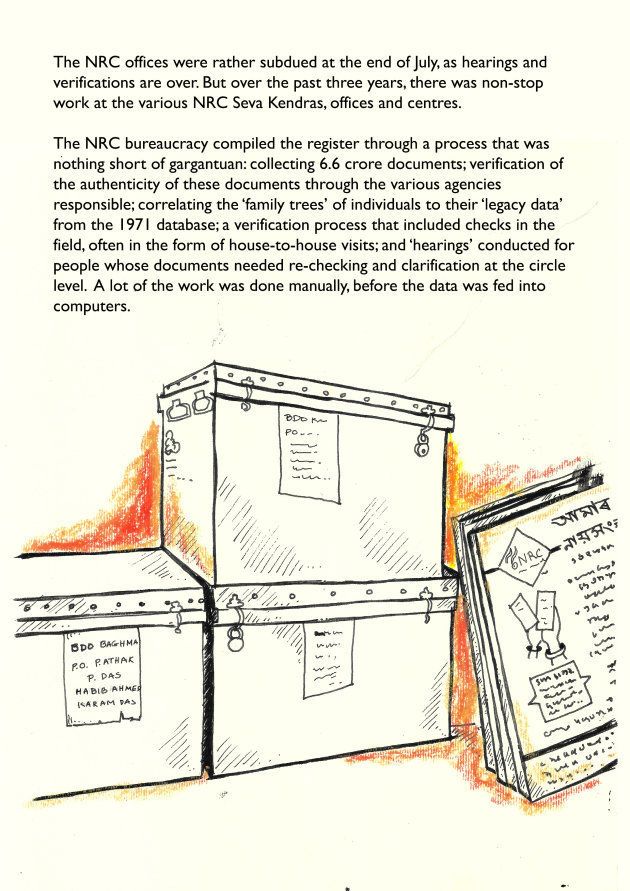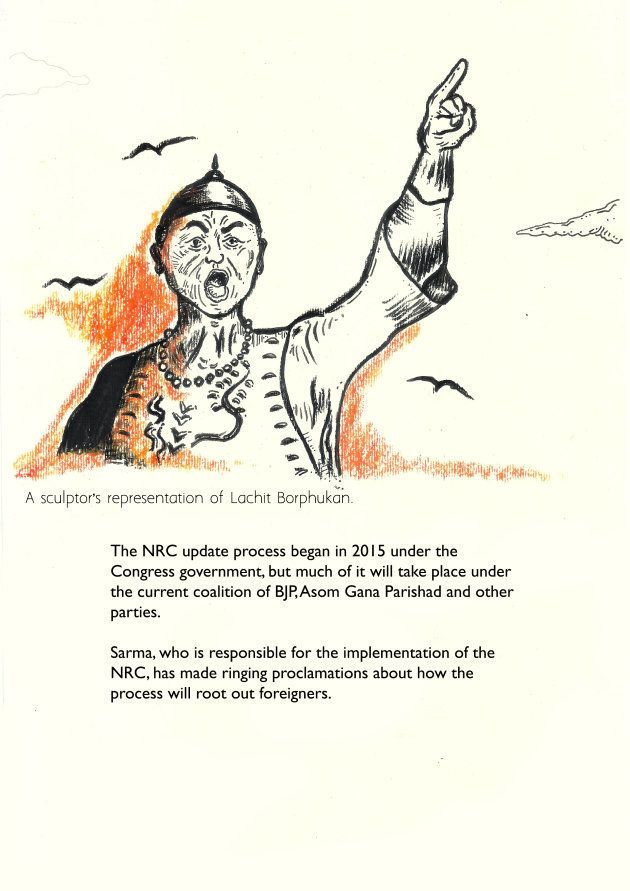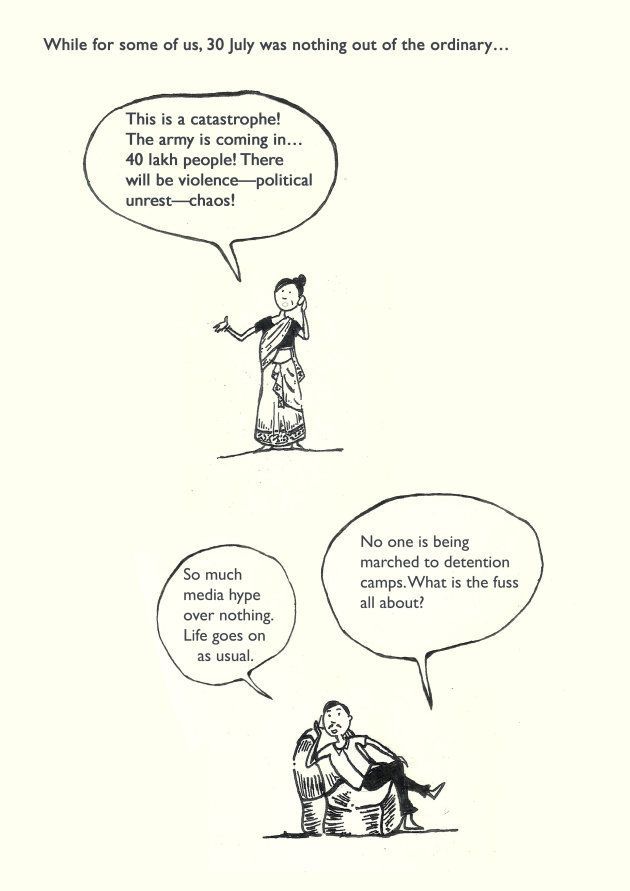
BISWANATH CHARIALI, Assam --Ji ei likhe, public or hoi likhibo.
"Whatever you write, write with the voice of the public."
This was a parting piece of advice given to me as I wrapped up my reporting at Kumolia village centre near the Biswanath Ghat area. I scrawled it absently along with my other notes on the page, another fragment from my many conversations about the updation of the National Register of Citizens (NRC).
But it is only in the course of the last month or so, as I noted the ebb and flow of the currents of public opinion, that the near impossibility of this dictum hit me.
How does one write with the voice of the public about a process that has left 4 million of that very same public in legal limbo?
In Assam in the month of July, if there was a wide consensus on anything, it was that the updating of the NRC was a good thing. I felt this sentiment was expressed across divides of ethnicity, class, religion and ideology—some supported it because they thought the process would finally identify the foreigners in their midst; another section supported it because they felt they would finally be included as Assamese.
As July turned to August, it was clear that the public was speaking in many voices.
It is another Independence Day in Assam—a place where independence has always evoked a complex welter of emotion.
Among the Original Inhabitants

Both Mrs. Gogoi and Shanti fall under the category of "original inhabitants" or "3 by 3s", in NRC parlance. The process has spawned a vocabulary of its own. "3 by 3s" refer to clause 3 (3) of the Schedule of the Citizenship (Registration of Citizens and Issue of National Identity Cards) Rules, 2003.
This category was introduced to ensure that no original inhabitant was "excluded from NRC due to unavailability of document". Those deemed "original inhabitants" would be allowed into the registry on the "basis of proof to the satisfaction of the Registering Authority", which means that the verification process of documents for people in this category is much less strenuous.
Except no one is quite sure how officials distinguish an "original inhabitant", or OI, from others. Prateek Hajela, the officer in charge of the whole process, says it is an internal category to ensure "bureaucratic ease", but officials insist the government will never publish exactly who is, or isn't, an original inhabitant.
One of the questions in the NRC's FAQ is:
Q: "Who are non-OIs?"
Ans: There is no such category as non-OI.
Shanti is a part of the "tea community"—one of the many people whose ancestors migrated to Assam from central India in the 19 and 20 centuries to work in tea plantations. As per a 2015 Supreme Court order, "tea communities" are also original inhabitants.
Uncomfortable Reunions

At hearings, entire families and individuals from all over Assam congregate at the NRC centres they are summoned to—sometimes from as far afield as Kathmandu—to verify legacy data and family trees.
When the family trees were being verified, especially in the months of February and March this year, the centres were thronging with people, as entire families and their many forked branches camped out from the early hours of morning, often until close to midnight.
"The NRC has even brought families together!"one officer told me.
When the folklore of the NRC process is written—and written it will be—there will be a whole chapter devoted to uncomfortable family reunions, I suspect.
A bureaucracy that is often vilified as corrupt and inefficient has cause to celebrate the successful completion of the NRC in a time-bound manner. There has been praise from commentators and a general sense of fulfillment after months of work. Yet, the perception of the NRC and its efficiency depends upon who is standing at the other end of the table and what her name is.
Complex Legacy

There are 855 martyrs of the Assam movement and these sahid bedis or memorials to the Assam Movement and its dead dot the landscape.
This number, however, does not include the lives lost in other incidents of 1983—the Nellie massacre, when 3,000 people of Bengali Muslim origin were massacred, or the Gohpur violence when Assamese and Bodos clashed a few months earlier.
The legacy of the Assam Movement remains complex; much water has flowed down Assam's many rivers since the Assam Accord was signed in the mid 1980s.
If the first part of the 1980s were the time of the Assam Movement, the late 1980s and 90s saw the movement for Bodoland intensify, with the demand that a homeland for the Bodo community be carved out of Assam. The same period witnessed the United Liberation Front of Assam's (ULFA) call for sovereignty and armed insurrection against the State.
Each movement had moments when questions and formulations of "indigenous and outsider" resulted in tensions between communities: often, this idea of the "son of the soil" could shift with the very soil one was standing on.
The Indian Army was deployed; and the counter-insurgency would forever change the fabric of democracy in the state.
The graffiti and slogans of the Bodo and ULFA groups have faded from public walls and shop fronts, yet the legacies of these movements remain, and continue to complicate the question of who exactly belongs to Assam and to whom Assam actually belongs.
The poet Kazi Neel's words have resonated more than once in this land—
That land is mine
I am not of that land
New Monuments


Two Brothers
Every day, Bodo, Karbi, Nepali, Muslim, Bihari, Marwari, Hindu Bengalis, Adivasis or members of 'tea tribe' and assorted Assamese groups walk past the jatiya bir memorial. Some of these communities fall under the NRC's formulation of 'original inhabitants' and some do not.
Sumit De, who drives me around in his electric auto, falls in the latter category.
Like many other partition migrants from what was then East Bengal, De's grandfather, too, had crossed the border into Assam's Cachar district from Sylhet in 1947. During the partition, large numbers of people came to Assam from Sylhet after it became a part of then East Pakistan.
After coming to Cachar, De's grandfather registered himself as a refugee and got his Refugee Registration Certificate. Then he began his new life in Cachar as a farmer.

Then there is the question of the Citizenship (Amendment) Bill 2016, under which refugees from certain religions will be given a chance for naturalization. There have been widespread protests around this bill in Assam. One of the options, says the BJP, is to relocate Hindu non- citizens to other states.
There is a marked contrast in the experience of the NRC process depending on which community you belong to. Regardless of who gets their name in the list and who doesn't, the experience of this process is bound to be different depending upon the community and history you profess, and what this portends for the future is a difficult question.

